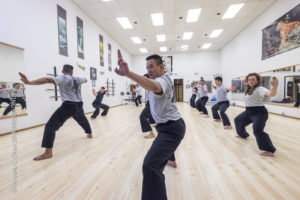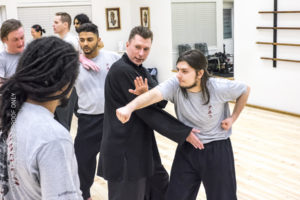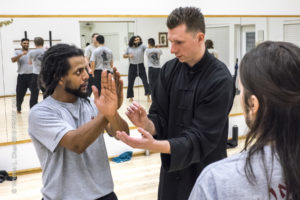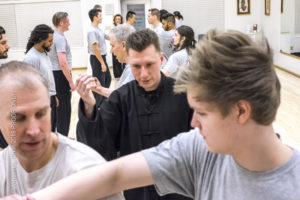About private lessons at our location
Serving the martial arts community in the Lower Mainland for more than forty years
Students come from Vancouver, Delta, Langley, White Rock, Coquitlam, New Westiminster, Burnaby and Surrey to study martial arts with Grandmaster Terlecki and Chief Instructor Klemczak. Instead of training in group taekwondo, karate or kickboxing, experience the power of private one on one lessons. Learn dynamic, effective, practical self defence techniques.
There are many martial arts schools in Vancouver, the Lower Mainland and the Fraser Valley to choose from; however, our school is the ONLY one that teaches PRIVATE martial arts FULL-TIME professionally. It is important to consider more than just location when selecting a master, if you want to get the most from your self defence and martial arts training. It is wise not to sacrifice a dedicated, experienced teacher for simple convenience, as many students have learned over the years.
https://www.facebook.com/kungfubc/videos/890075124373465/
In a group situation an instructor spends approximately 4 minutes with each individual, (based on a 60 minute class and 15 students). In a private lesson, the student receives 60 minutes of the instructor’s time. Therefore, it is obvious that one on one instruction is by far a more superior method of teaching martial arts. Because of this format of instruction, one year of training at the Academy is equivalent to 5 years of training at any other martial arts school that teaches group classes.
Short History of:
Taekwondo:
Taekwondo is a martial art originating in Korea. In 1989, taekwondo was the world’s most popular martial art and it has been an Olympic sport since 2000.
Taekwondo was developed by major general Choi Hong Hi in Korea in 1955 as partial combination of Taekkyeon (traditional Korean martial art from the Josseon Dynasty) and Okinawan Karate. There are two main branches of tae-kwon-do development, although they are not mutually exclusive. Traditional tae kwon do typically refers to the martial art as it was established in the 1950s and 1960s in the South Korean military and in various civilian organizations, including schools and universities. In particular, the names and symbolism of the traditional patterns often refer to elements of Korean history, culture and religious philosophy.
Traditional Tae-kwon-do may refer to International Tae-Kwon-Do Federation.
Sport taekwondo has developed in the decades since the 1950s and may have a somewhat different focus, especially in terms of its emphasis on speed and competition. Sport tae kwon do is in turn subdivided into two main styles. One style is practiced by International Taekwondo supporters and was created in 1955 by General Choi Hong Hi. The other style derives from Kukkiwon, the source of the sparring system sihap gyeorugi. This style is now an event at the summer Olympic Games and is governed by the World Taekwondo Federation. (WTF). The Kukkiwon – or World Taekwondo Headquarters – is the traditional center for WTF taekwondo and was founded in 1973 by Dr. Kim Un Yong.
Although there are doctrinal and technical differences between sparring in the two main styles and among the various organizations, the art in general emphasizes kicks and punches thrown from a mobile stance. Taekwondo training generally includes a system of blocks, kicks, punches, and open-handed strikes. Many self-defense techniques were borrowed from other martial arts, such as Japanese Judo, Okinawan Karate and some Kung-Fu styles of Northern China. In Korean, tae (?, ?) means “to strike or break with foot”; kwon (?, ?) means “to strike or break with fist”; and do (?, ?) means “way”, “method”, or “path”. Thus, taekwondo may be loosely translated as “the way of the foot and the hand.”[3] The name taekwondo is also written as taekwon-do, tae kwon-do or tae kwon do by various organizations.
Karate:
Karate is a martial art developed in the Ryukyu Islands in what is now Okinawa, Japan. It was developed partially from indigenous fighting methods called te ( literally “hand”; and from Chinese kenpo. Karate is a striking art using punching, kicking, knees, elbow strikes, and open-handed techniques such as knife-hands. Grappling, locks, restraints, throws, and vital point strikes are taught in some styles.
There are several different styles of karate, most of them stemming from the same genealogical tree, and some others acquiring the name “karate” for practical reasons while actually deriving from a mix of other martial arts. Each style of karate stresses some techniques more than others, or has some differences in performing the same techniques from what other styles do. However, most karate schools and styles adhere to the same basic principles, and use the same basic attire, stances and terminology.
Karate was possibly developed in the Ryukyu Istands prior to its 19th-century annexation by Japan, but there is no historical proof that karate (Okinawan te or karate-jutsu) was taught in Japan before 1912. It was brought to the Japanese mainland in the early 20th century during a time of cultural exchanges between the Japanese and the Ryukyuans.
In 1922 the Japanese Ministry of Education invited great karate master Funakoshi Gichin to Tokyo to give a karate demonstration. In 1924 Keio University established the first university karate club in Japan and by 1932, major Japanese universities had karate clubs. In this era of escalating militarism in Japan the name was changed from “Chinese hand” or “Tang hand” verbatim, (as the name of the Tang Dynasty was a synonym to China in Okinawa) to “empty hand” – both of which are pronounced karate – to indicate that the Japanese wished to develop the combat form in Japanese style. After the Second World War,Okinawa became an important US military site and karate became popular among servicemen stationed there.
For many practitioners, karate is a deeply philosophical practice. Karate-do teaches ethical principles and can have spiritual significance to its adherents. Gichin Funakoshi (“Father of Modern Karate”) titled his autobiography Karate-Do: My Way of Life in recognition of the transforming nature of karate study. Today karate is practiced for self-perfection, for cultural reasons, for self-defense and as a sport.
Wikipidia
Kickboxing:
Kickboxing Overview
Since kickboxing is a broad term that can be used both in a wide and narrow sense, this can make understanding the history somewhat difficult. Some of the earliest forms of kickboxing included the various Indochinese martial arts especially muay boran, which developed into modern muay thai.
However in terms of modern competition, it was during the 1950s when a Japanese karateka named Tatsuo Yamada first established an outline of a new sport that combined karate and muay thai.
This was further explored during the early 1960’s, when competitions between karate and muay thai began, which allowed for rule modifications to take place. By the middle of the decade the first true kickboxing events were being held in Osaka. By the 1970’s and 1980’s the sport had expanded beyond Japan and had reached North America and Europe.

Kickboxing (in Japanese kikkubokushingu) is a group of martial arts and stand up combat sports based on kicking and punching, historically developed from Karate, Muay Thai and Western boxing, Kickboxing is often practiced for general fitness, or as a contact sport.
Japanese kickboxing originated in the 1960s, with competitions. American kickboxing originated in the 1970s. Japanese kickboxing developed into K-1 in 1993. Historically, kickboxing can be considered a hybrid martial art formed from the combination of elements of various traditional styles. This approach became increasingly popular in the 1970s, and since the 1990s, kickboxing has contributed to the emergence of mixed martial arts via further hybridization with ground fighting techniques from jujutsu and collegiate wrestling.
There is no single international kickboxing governing body. Governing bodies include World Association of Kickboxing Organizations, World Kickboxing Association, International Kickboxing Federation, among others. Consequently there is no single kickboxing World Championship, and champion titles are issued by individual promotions, such as K-1, It’s Showtime, Lumpinee Kickboxing Stadium, and others.
The term “kickboxing” can be used in a narrow as well as a wide sense.
- The narrow use is restricted to the styles that self-identify as kickboxing, i.e. Japanese kickboxing (with its spin-off styles or rules such as Shoot kickboxing and K-1), and American kickboxing.
- In the wider sense, it includes all stand-up combat sports that allow both punching and kicking, including Savate, Muay Thai, Indian boxing, Burmese kickboxing, Sanda (Chinese kickboxing which allows take downs) and various styles of Karate, etc.
The term kickboxing itself was introduced in the 1960’s as a Japanese anglicism by Japanese boxing promoter Osamu Noguchi for a hybrid martial art combining Muay Thai and karate which he had introduced in 1958. The term was later adopted by the American variant. Since there has been a lot of cross-fertilization between these styles, with many practitioners training or competing under the rules of more than one style, the history of the individual styles cannot be seen in isolation from one another.
The French term Boxe pieds-poings (literally “feet-fists-boxing”) is also used in the sense of “kickboxing” in the general meaning, including French kickboxing (savate) as well as American and Japanese kickboxing, Burmese and Thai kickboxing, etc.
Driving Directions to 102 – 13463 78th Ave, Surrey, B.C.
From Langley and Cloverdale
When driving from Langley or Cloverdale, take 88th Ave, #10 Hwy or 64th Ave. to 152nd St. Turn West on 72nd Ave. (note: 72 Ave begins at 152nd St)
From White Rock or South Surrey
When driving from White Rock or South Surrey, take King George Hwy and turn left on 78th Ave.
From Vancouver, Burnaby or New Westminster via Hwy 99
If you’re driving from Vancouver, Burnaby or the New Westminster area from Hwy 91, exit left to 72 Avenue, through Delta, 1km after crossing the Alex Fraser Bridge. Follow 72nd Ave and turn left on King George Hwy. Turn left on 78 th Avenue.
From Coquitlam, Vancouver, Burnaby via Hwy 1
When driving from Coquitlam, Vancouver, or the Burnaby area from Hwy 1 off the Port Mann Bridge, take the exit to 152nd St. Go south on 152 St.,, turn right (East) on 72nd Ave. Turn right on King George Hwy and left on 78th Ave.
From New Westminster, Burnaby via Patullo Bridge
When driving from Burnaby or New Westminster area from the Patullo Bridge. Follow King George Hwy and turn right on 78th Ave.
The Academy is located on major bus routes connecting from the Surrey Central skytrain station and the Newton Bus Loop via #321 on King George Hwy and #324 via 132nd St.
Why settle for group classes when you can experience the power of learning one on one…
You will learn how to stay calm in life threatening situations
How to respond with explosive and effective techniques
Training results – confidence, superior skill, longevity and great health
The power of qui gong
The balance of mind and body
Living meditation
Effective and powerful self defence techniques
You will learn powerful and efficient techniques that will be instantly effective.
Learn unique, innovative and dynamic techniques that will have the utmost effect and will impact your martial arts training for the rest of your life.




